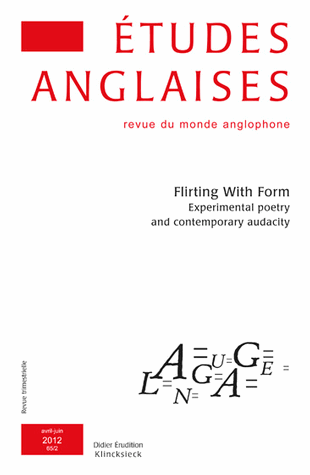
Etudes anglaises: Flirting with form – Experimental poetry and contemporary audacity
issue #2, 2012

|
order from Klincksieck, Paris. Penelope GALEY-SACKS : Introduction. A Field of New Voicings ARTICLES Charles BERNSTEIN and Penelope GALEY-SACKS: Poetry's club-foot: process, faktura, intensification (an interview) Marie-Dominique GARNIER: Madeline Gins’s Ors Poetica Or Reading "Critical Beach" (Helen Keller Or Arakawa, 1994) Hélène AJI: Un(decidable), Un(creative), Un(precedented), Un(readable), Un(nerving): Christian Bök, Craig Dworkin, Kenneth Goldsmith and Vanessa Place Penelope GALEY-SACKS: Songlines and Entropy in Ron Silliman’s Ketjak John SEARS: The Horizon of the Poem: On Matthew Cooperman and Ecopoetics Axel NESME: Etant Donné(e) Rachel Blau DuPlessis: Intertextuality and Intermediality in Drafts 1-38, Toll Geneviève COHEN-CHEMINET : La matérialisation de la marge dans la poésie américaine contemporaine Dominique DELMAIRE: The love poetry of George Mackay Brown, or “The Escape of the H(e)art”
Penelope GALEY-SACKS: (Charles Bernstein on) Language and L=A=N=G=U=A=G=E |
||
|
Marie-Dominique GARNIER - Madeline Gins's Ors Poetica Or Reading "Critical Beach" (Helen Keller Or Arakawa, 1994) Except for an isolated attempt at translating one of Arakawa and Gins’s early essays, To Not To Die (Pour ne pas mourir), the poetry of Madeline Gins has not, so far, been translated into French—although her first volume Word Rain was published to great acclaim in 1969. Gins’s 1994 Helen Keller Or Arakawa belongs to no known genre. Part-“novel” part-aesthetic philosophy and survival manual, it belongs to the genre-to-be of many-body biography, one in which bodies and their surroundings are treated as part of a common bioscleaving project. While “ecosophy” or “ecopoetry” might come to mind as ways of describing the sort of “atmospheric” connectivity Gins and Arakawa are seeking, both terms miss the radical novelty of their biopoetics. At work in Gins and Arakawa is a critique both of the “I” and of the “environment,” each being remodeled into a “sky-of-an-I” and a “surround” or an “atmosphere.” In the last “chapter” (or plateau) of Helen Keller Or Arakawa, a beach gone “critical” speaks a post-human, minor poetic tongue of its own. This essay addresses the “ecopoetics” of critical beach parlance—a beach devoid of any phenomenological horizon. Differential, repetitive, each throw of Gins’s poetic dice looks or gropes ahead in the direction of an exopoetics: a turning inside-out of the “innards” of language. Mise à part la tentative isolée de traduire To Not To Die, un des premiers essais co-écrits par Arakawa et Gins, la poésie de Madeline Gins n’est pas, à ce jour, traduite en français — et cela malgré le fait que son premier recueil, Word Rain, ait été acclamé à sa publication. Le volume in-titulé Helen Keller or Arakawa ne ressortit quant à lui à aucun genre répertorié. Mi-« roman », mi-traité de philosophie esthétique et manuel de survie, cet « essai » poétique relève d’un genre inconnu, celui de la biographie à n-corps — biographie dont les corps et ce qui les entoure; relè-vent du même projet de « bioaderrance ». Si des mots-clefs tels que « écosophie » ou « écopoé-sie » peuvent a priori sembler en adéquation avec la connectivité de type « atmosphérique » que cherchent à construire Arakawa et Gins, ces termes restent l’un et l’autre en deçà de leur biopoé-tique d’un genre radicalement nouveau. Une double critique opère chez Gins et Arakawa : celle du sujet, et celle de l’environnement, l’un et l’autre revus et corrigés en « aire-de-je » et en « pa-rages » ou « atmosphère ». Le dernier chapitre (ou plateau) de Helen Keller Or Arakawa donne la parole à une plage devenue « critique », plage post-humaine possédant sa propre langue poé-tique mineure. Il s’agit dans le présent essai d’établir le profil « écopoétique » de cette plage par-lante — et dépourvue du moindre horizon phénoménologique. À chacun des lancers de ses dés poétiques, répétitifs et différentiels, l’écriture de Madeline Gins en appelle à un deve-nir-exopoétique — à une mise au grand dehors du dedans du langage.
Hélène AJI - Un(decidable), Un(creative), Un(precedented), Un(readable), Un(nerving): Christian Bök, Craig Dworkin, Kenneth Goldsmith and Vanessa Place Penelope GALEY-SACKS - Songlines and Entropy in Ron Silliman’s Ketjak
Axel NESME - Étant Donné(e) Rachel Blau DuPlessis: Intertextuality and Intermediality in Drafts 1-38, Toll
|
||